Milad Tatar Mamaghani
Securing Integrated Sensing and Communication Against a Mobile Adversary: A Stackelberg Game with Deep Reinforcement Learning
Jan 04, 2025Abstract:In this paper, we study a secure integrated sensing and communication (ISAC) system employing a full-duplex base station with sensing capabilities against a mobile proactive adversarial target$\unicode{x2014}$a malicious unmanned aerial vehicle (M-UAV). We develop a game-theoretic model to enhance communication security, radar sensing accuracy, and power efficiency. The interaction between the legitimate network and the mobile adversary is formulated as a non-cooperative Stackelberg game (NSG), where the M-UAV acts as the leader and strategically adjusts its trajectory to improve its eavesdropping ability while conserving power and avoiding obstacles. In response, the legitimate network, acting as the follower, dynamically allocates resources to minimize network power usage while ensuring required secrecy rates and sensing performance. To address this challenging problem, we propose a low-complexity successive convex approximation (SCA) method for network resource optimization combined with a deep reinforcement learning (DRL) algorithm for adaptive M-UAV trajectory planning through sequential interactions and learning. Simulation results demonstrate the efficacy of the proposed method in addressing security challenges of dynamic ISAC systems in 6G, i.e., achieving a Stackelberg equilibrium with robust performance while mitigating the adversary's ability to intercept network signals.
Secure Short-Packet Transmission with Aerial Relaying: Blocklength and Trajectory Co-Design
Oct 08, 2023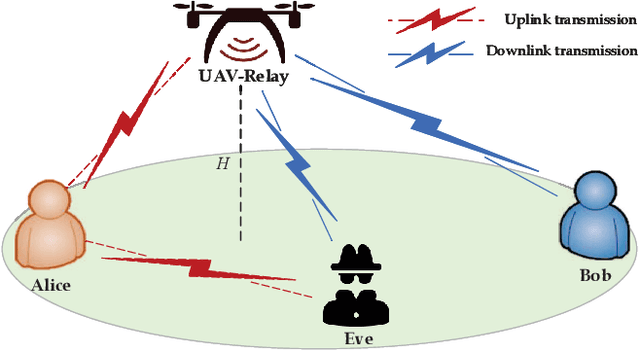
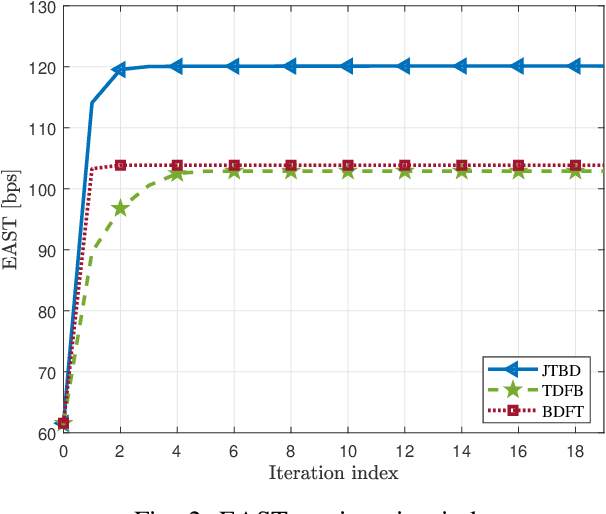
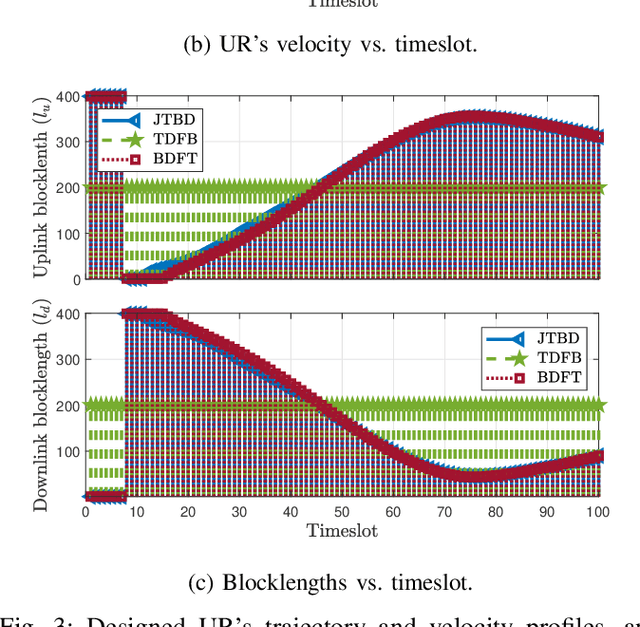
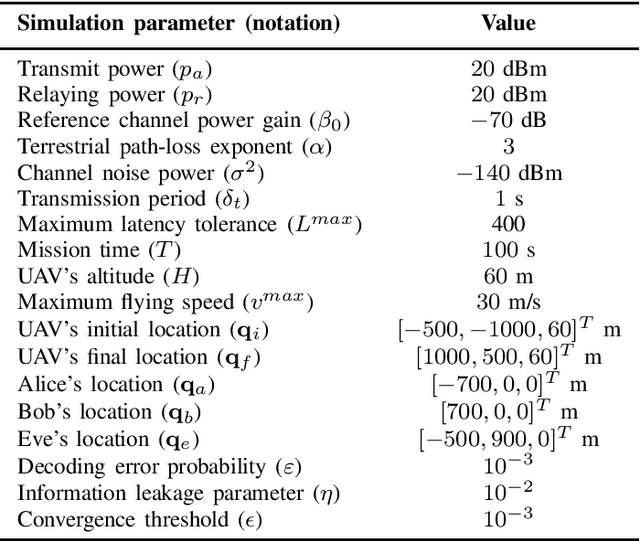
Abstract:In this paper, we propose a secure short-packet communication (SPC) system involving an unmanned aerial vehicle (UAV)-aided relay in the presence of a terrestrial passive eavesdropper. The considered system, which is applicable to various next-generation Internet-of-Things (IoT) networks, exploits a UAV as a mobile relay, facilitating the reliable and secure exchange of intermittent short packets between a pair of remote IoT devices with strict latency. Our objective is to improve the overall secrecy throughput performance of the system by carefully designing key parameters such as the coding blocklengths and the UAV trajectory. However, this inherently poses a challenging optimization problem that is difficult to solve optimally. To address the issue, we propose a low-complexity algorithm inspired by the block successive convex approximation approach, where we divide the original problem into two subproblems and solve them alternately until convergence. Numerical results demonstrate that the proposed design achieves significant performance improvements relative to other benchmarks, and offer valuable insights into determining appropriate coding blocklengths and UAV trajectory.
Secure Short-Packet Communications via UAV-Enabled Mobile Relaying: Joint Resource Optimization and 3D Trajectory Design
Jul 14, 2023Abstract:Short-packet communication (SPC) and unmanned aerial vehicles (UAVs) are anticipated to play crucial roles in the development of 5G-and-beyond wireless networks and the Internet of Things (IoT). In this paper, we propose a secure SPC system, where a UAV serves as a mobile decode-and-forward (DF) relay, periodically receiving and relaying small data packets from a remote IoT device to its receiver in two hops with strict latency requirements, in the presence of an eavesdropper. This system requires careful optimization of important design parameters, such as the coding blocklengths of both hops, transmit powers, and UAV's trajectory. While the overall optimization problem is nonconvex, we tackle it by applying a block successive convex approximation (BSCA) approach to divide the original problem into three subproblems and solve them separately. Then, an overall iterative algorithm is proposed to obtain the final design with guaranteed convergence. Our proposed low-complexity algorithm incorporates 3D trajectory design and resource management to optimize the effective average secrecy throughput of the communication system over the course of UAV-relay's mission. Simulation results demonstrate significant performance improvements compared to various benchmark schemes and provide useful design insights on the coding blocklengths and transmit powers along the trajectory of the UAV.
Aerial Intelligent Reflecting Surface Enabled Terahertz Covert Communications in Beyond-5G Internet of Things
Nov 23, 2021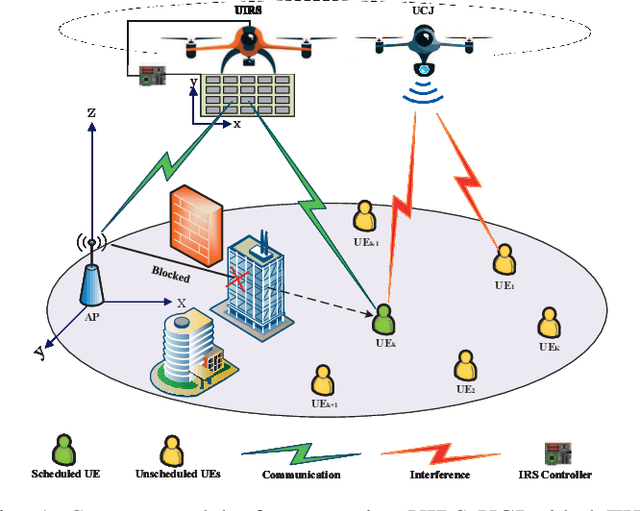
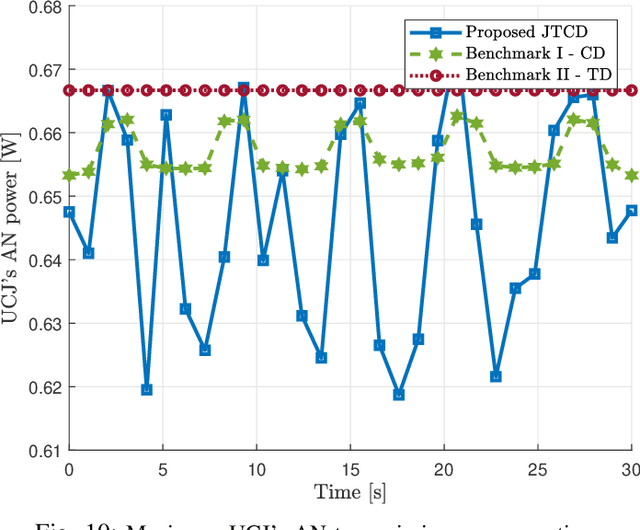
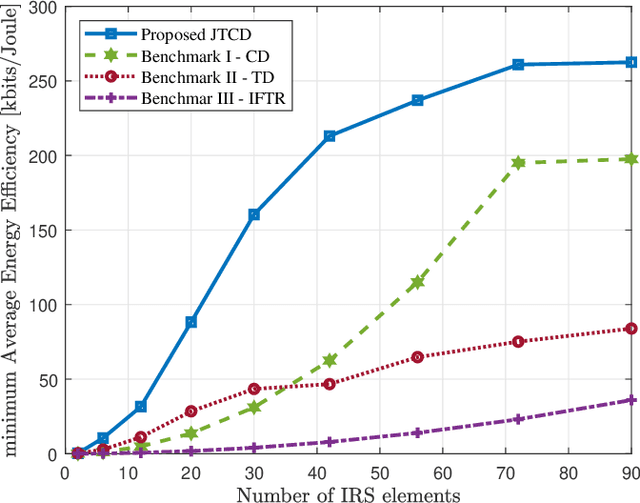
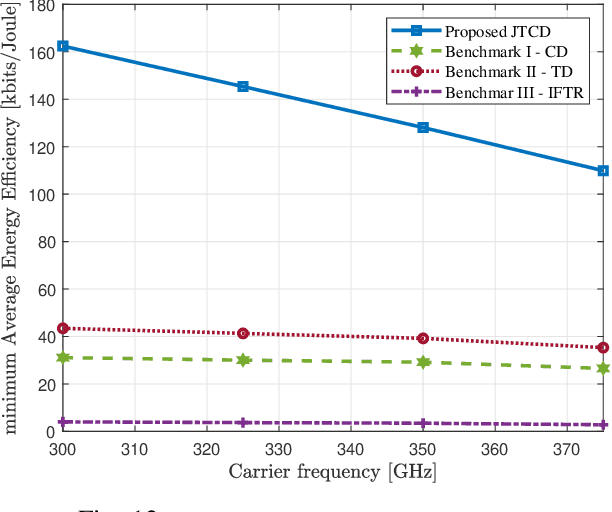
Abstract:Unmanned aerial vehicles (UAVs) are envisioned to be extensively employed for assisting wireless communications in Internet of Things (IoT) applications. On the other hand, terahertz (THz) enabled intelligent reflecting surface (IRS) is expected to be one of the core enabling technologies for forthcoming beyond-5G wireless communications that promise a broad range of data-demand applications. In this paper, we propose a UAV-mounted IRS (UIRS) communication system over THz bands for confidential data dissemination from an access point (AP) towards multiple ground user equipments (UEs) in IoT networks. Specifically, the AP intends to send data to the scheduled UE, while unscheduled UEs may pose potential adversaries. To protect information messages and the privacy of the scheduled UE, we aim to devise an energy-efficient multi-UAV covert communication scheme, where the UIRS is for reliable data transmissions, and an extra UAV is utilized as a cooperative jammer generating artificial noise (AN) to degrade unscheduled UEs detection. We then formulate a novel minimum average energy efficiency (mAEE) optimization problem, targetting to improve the covert throughput and reduce UAVs' propulsion energy consumption subject to the covertness requirement, which is determined analytically. Since the optimization problem is non-convex, we tackle it via the block successive convex approximation (BSCA) approach to iteratively solve a sequence of approximated convex sub-problems, designing the binary user scheduling, AP's power allocation, maximum AN jamming power, IRS beamforming, and both UAVs' trajectory planning. Finally, we present a low-complex overall algorithm for system performance enhancement with complexity and convergence analysis. Numerical results are provided to verify our analysis and demonstrate significant outperformance of our design over other existing benchmark schemes.
THz Transmission meets Untrusted UAV-Relaying; Trajectory and Communication Co-design for Secrecy Energy Efficiency Maximization
Jul 21, 2021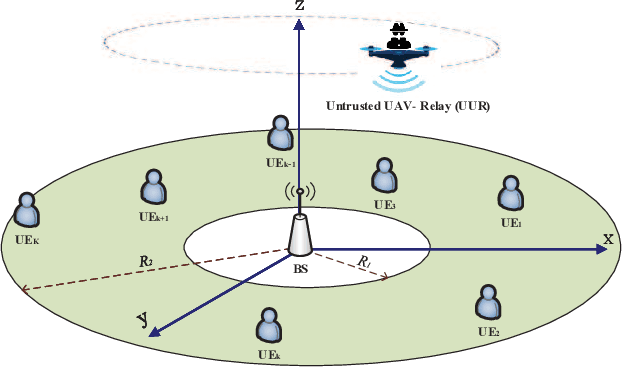
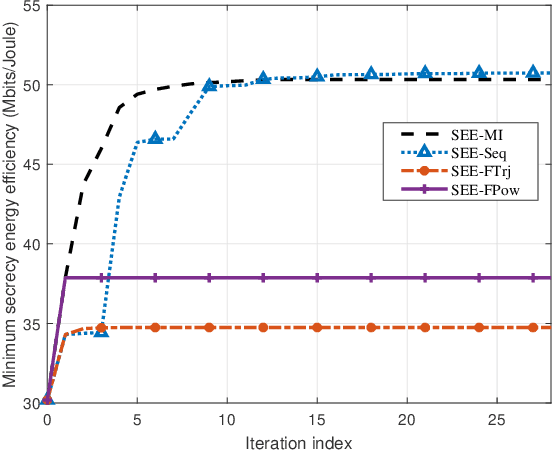


Abstract:Unmanned aerial vehicles (UAVs) and Terahertz (THz) technology are envisioned to play paramount roles in next-generation wireless communications. Hence, this paper presents a novel secure UAV-assisted mobile relaying system operating at THz bands for data acquisition from multiple ground user equipments towards a destination. We assume that the UAV-mounted relay may act, besides providing relaying services, as a potential adversary called the untrusted UAV relay. To safeguard end-to-end communications, we present a secure two-phase transmission strategy with cooperative jamming. Then, we formulate an optimization problem in terms of a new measure $-$ secrecy energy efficiency (SEE), defined as the ratio of achievable average secrecy rate to average system power consumption, which enables us to obtain the best possible security level while taking UAV's inherent flight power limitation into account. This optimization problem leads to a joint design of key system parameters, including UAV's trajectory and velocity, communication scheduling, and power allocations. Since the formulated problem is a mixed-integer nonconvex optimization and computationally intractable, we propose alternative algorithms to solve it efficiently via greedy/sequential block coordinated descent, successive convex approximation, and non-linear fractional programming techniques. Numerical results demonstrate significant SEE performance improvement of our designs when compared to other known benchmarks.
 Add to Chrome
Add to Chrome Add to Firefox
Add to Firefox Add to Edge
Add to Edge